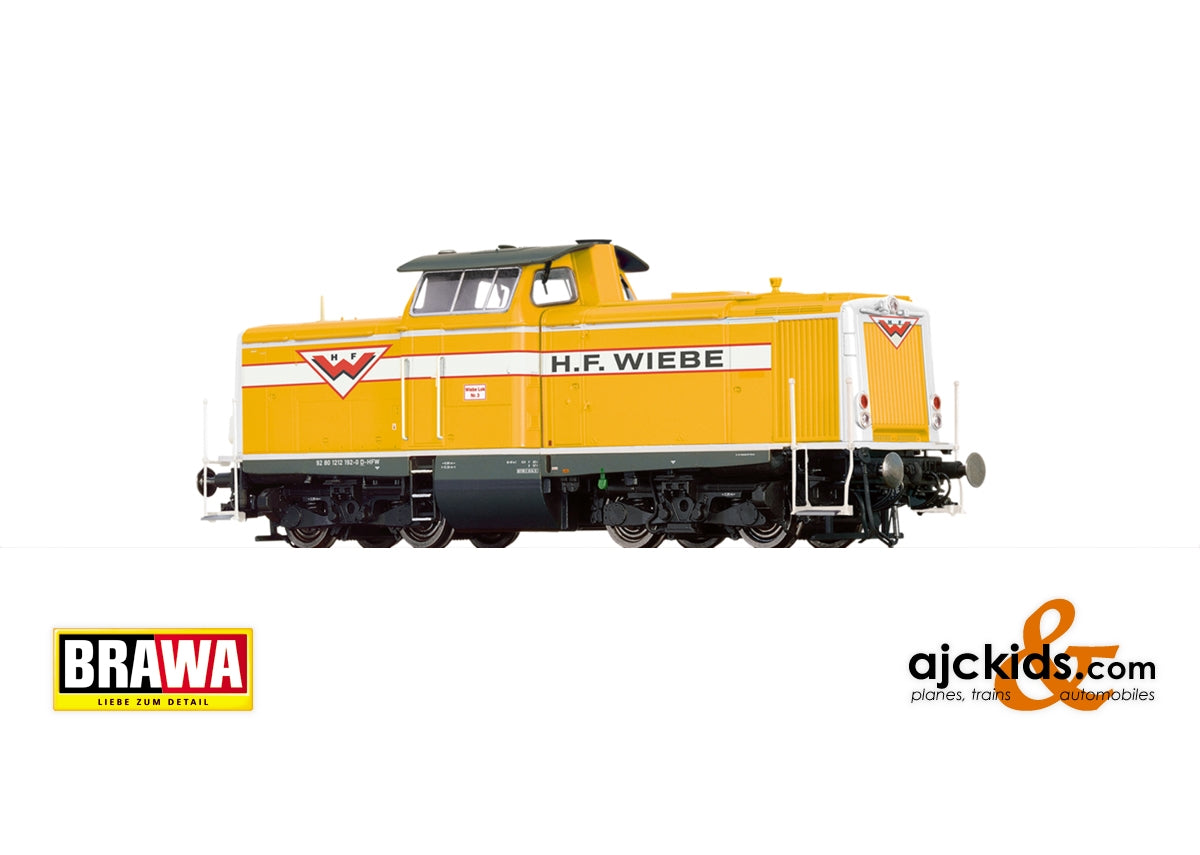Brawa 42890 - Diesel Locomotive BR212 Wiebe, V, DC Digital Extra
Diesel Locomotive BR212 Wiebe, V, DC Digital Extra
Road no.: 92 80 1212 192-9
MODEL DETAILS
- Etched cooler grille and fan grille
- Free-standing handrails
- Spring buffers
- Clear view through the driver's cabin
- Realistic reproduction of the tubular frame bogies incl. axle drive
- Reproduction of brake rods
- All specific details of the different series taken into consideration
- Completely recreated driver's cab
- Zinc die-cast chassis and gear housing
- Lights fitted with maintenance-free LEDs
DIGITAL EXTRA: COMPLETE WITH THE FOLLOWING FEATURES THAT CAN BE DIGITALLY CONTROLLED:
- Sound
- Automatic decoupling
- Driver's cabin lighting
- Driven fans
- Shunting light and red light can be individually controlled
OVERVIEW OF TECHNICAL FUNCTIONS
| Driving function |  |
 |
 |
 |
| Light change |  |
 |
 |
 |
| Tail lights separately switchable |
 1) 2) 1) 2) |
 1) 1)
|
 |
 |
| Driver cabin lighting |
 1) 2) 1) 2)
|
 1) 1)
|
 |
 |
| Shunting lights |
 1) 2) 1) 2)
|
 1) 1)
|
 |
 |
| Light setting programmable for analogue operation |  |
 |
 |
 |
| Digital interface | PluX22 | PluX22 | PluX22 | PluX22 |
| Decoder |  |
 |
 |
|
| Sound |  |
 |
||
| Functional fan |  |
 |
||
| Digital coupling (NEM-standard close coupling) |  |
 |
||
| Locomotive card |  |
|||
| Additional information |
|
|
|
|
1) Function only available in digital mode
2) Programmable for analogue operation
INFO ABOUT THE ORIGINAL
With the adoption of the 1955 diesel locomotive type program, the foundation for a success story was laid at the Deutsche Bundesbahn (DB) [German Federal Railway] that, to some extent, continues to the present day. The decision was made to develop a diesel locomotive for the secondary railway service with an engine output of between 1,000 and 1,200 HP, the V100 series. Based upon the slightly older V 80, the Bundesbahn Central Office in Munich issued concrete change requests to the MaK Company in order to significantly reduce the costs for the new locomotives. By 1957, this resulting catalogue of requirements thus lead to a largely completed construction of which the Deutsche Bundesbahn ordered six trial locomotives. MaK manufactured a further locomotive at ist own cost in order to also be able to address customers other than DB. With the V100 000, the first of 744 manufactured locomotives of the V100 series left the MaK factory halls in Kiel in March 1958. Like no other locomotive series, it embodied the structural change on the railway that was inevitibly coming. In the middle of Germany's economic miracle, the crimson locomotives shaped the image of the young, modern Deutsche Bundesbahn and sent numerous old steam locomotives to the blast furnaces. The diverse applicability of all three sub-types ensured that the V100 was widely distributed throughout Germany and kept many less frequented secondary railways alive. Approximately a third of all V100 locomotives were equipped with a push-pull train control and multitraction control ex works in order to do away with the time-intensive shunting in train stations where it was necessary to turn the train around. At the beginning of the 1970s, individual locomotives started to be equipped with front-mounted snow ploughs. The first large quantities of the V100.10 (211) were only withdrawn from service at the end of the 1980s. This process only started approximately 10 years later for the V100.20 (212). A reasonably large amount were sold on to other railway companies abroad. Thanks to their reliability and robustness in particular, there are still a few locomotives in operation today after approximately 50 years of operation and are largely being used by private railway companies in Germany.
For reasons of differentiation and as the V100 006 was already equipped with a 1,350 HP engine at the point of the first volume production order, all other trial locomotives as well as the recently ordered 1,100 HP locomotives were operated as the V100.10 series. At first glance, it is difficult to notice the differences between the V100.10 series and the trial locomotives. For instance, simple rods were now used in place of the bow-shaped manoeuvring handles and the lower lights were implemented as dual lights.
EAN/UPC: 4012278428901



